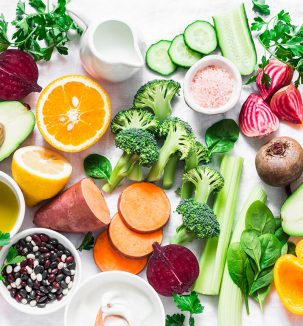Modern wheat is very different to the wheat that our ancestors ate. It is high in protein, and generous in fat, but it is lacking many amino acids and provides a relatively meagre vitamin and mineral content. All wheat undergoes a refining process which destroys the healthful live enzymes and between 25-75% of the nutrients, meaning that even whole-wheat flour is bereft of much of its original nutrition.
Gluten now constitutes 78% of the total protein in modern wheat, and in particular its smaller derivative gliadin, that is an intestinal irritant and causes allergic reactions. The body reacts to it as if it were an invader. When yeast reacts with sugar it produces bubbles of gas that expand more easily the more gluten there is in the dough. So the higher the gluten content, the ‘lighter’ the loaf, but the harder it is on our intestines. Adverse reactions to bread are far more common than to pasta, which is often made from ‘hard wheat’ with a lower gluten content.
Gluten is also found in rye, spelt, barley and oats. Gluten-sensitive people should avoid all of these gluten grains. Gliadin, however, is not found in oats.
Wheat can be found in all of the following products: Bread, bagels, matzo, buns, bread stuffing, biscuits, pizza, breadcrumbs, croutons, crackers, bulgur, couscous, corn bread, dumplings, muffins, pancakes, pasta pies, pitta bread, waffles, breaded food, breakfast cereals, most sausages, pasta, semolina, beer, battered foods, many ready-made food and sauces
On labels wheat may be presented as: Flour, semolina, graham flour, durum semolina, vital wheat gluten, gluten, wheat starch, cracked wheat, farina, bran
Wheat Substitutes: Alternative cereal grains: (contain gluten) – Barley, Rye, Oats, Spelt,
Non-cereal alternatives: Amaranth, buckwheat, quinoa, bean flours (soy, chickpeas), corn, millet, rice, tapioca, kamut and sorghum.
Alternatives to gluten based breads (available from good health food shops and some supermarkets):
- Rice cakes, Corn cakes, Millet bread, Kamut bread
- Good health food shops will sell delicious gluten free breads such as quinoa, buckwheat or rice bread.
- Artisan Bread have been baking gluten-free bread since 2014. Each day they freshly mill the grains and pulses that go into their breads to avoid oxidation and to ensure a sweet and fresh taste. No baker’s yeast is added to most breads, instead they have developed their own gluten-free organic leaven and use a 15-hour fermentation process. The bread is ripened before it is baked resulting in superb taste, texture and digestibility. Where they do use it is ORGANIC developed by Agrano. Visit their on-line bakery at: https://www.artisanbread-abo.com/
Recommended Cookery Books:
Cooking without – Barbara Cousins
Any of the Vegetarian cookery books by Rose Elliot.
References:
Baic S, Denby N, Korn D (2007) Living Gluten Free for Dummies (UK Edition). West Sussex: Joh Wiley & Sons Ltd
Coeliac UK, Available at: http://www.coeliac.org.uk/
Karr J (2012) What is Gluten and What’s Gluten in: What you need to know about Gluten (The Silent Killer) Canada: Blackwave Pubishing
Mayo Clinic Gluten-free diet: Whats alowed, whats not Available at: http://www.mayoclinic.com/health/gluten-free-diet/my01140
Murray M, Pizzorno J & Pizzorno L (2010) The encyclopaedia of Healing Foods Singapore: Piatkus.
Petersen V, Petersen R (2009) The Gluten Effect: How Innocent Wheat is Ruining your Health California: True Health Publising







